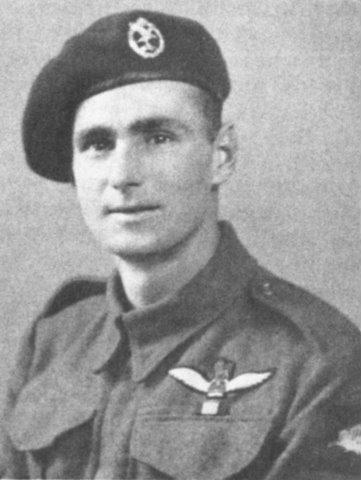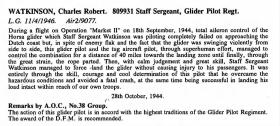Charles Rollett Watkinson was born on the 3 April 1913 and came from Falmouth in Cornwall. He was working as a clerk at the Employment Exchange when war was declared. [1]
Staff-Sergeant Ron Watkinson joined the Army on the 30 April 1931, [2] and saw active service with the Royal Artillery on the North-West Frontier in 1937. He was released to the Reserves on the 24 February 1938, and was mobilised on the 26 August 1939. [1]
He was posted to Gibraltar, and in 1942, he applied to join the RAF as a crewman, but transferred to the Glider Pilot Regiment and learned how to fly.
Upon completion of his flying training and qualifying as a glider pilot he served at No. 6 Maintenance Unit, Tug Flight., RAF Brize Norton, October to November 1943, testing and ferrying Horsa gliders. He also served at No 15 Maintenance Unit at RAF Wroughton. (One of his fellow glider pilots during this period was Sgt. William Kenneth ‘Billy’ Marfleet, who would go on to serve in ‘A’ Squadron, and was killed on 6 June 1944, on Operation ‘Tonga’). [3]
At Arnhem, he was the first pilot of a Horsa glider, Chalk No.878, carrying a 75mm Pack Howitzer, Jeep, ammunition trailer and four men of No.2 Battery, 1st Airlanding Light Regiment, with the Second Lift on Monday 18 September. Towed by an Albemarle of 297 Squadron from Manston, the Horsa was hit by flak over the city of Middelburg, located on one of the islands off the Dutch coast, and an aileron was damaged. Watkinson wrote:
“Hit with flak near Middelburgh, which cut the aileron control wire and air pipes, making ailerons and most of instruments, including the Air Speed Indicator useless. No person injured, but a fair number of holes in fuselage and load.
“I regained as much control as possible, without ailerons, but the glider continued to swing, pendulum fashion, behind the tug. Kept in contact with the tug pilot, who suggested we turn around and make our way back to the English coast, to ‘ditch’. I declined and said, “If we can go back, we can go on”.
“We carried on towards Arnhem for about another 20 minutes, when the tow rope broke. The glider was easier to control in free flight, but the landing gear would not jettison, (found out later that the locking wires had not been removed), we had no airspeed indicator or altimeter and the flaps were not working, as well as the ailerons.
“I managed to get it down close to a farm, near the village of Dinteloord [or Fijnaart], in the province of Brabant. The nose wheel broke and came into the cockpit, but no-one injured."
“A host of Dutch men and women came out to greet us, (none spoke English). After embracing us we all set to unload the glider. We then had problems, the flak had buckled the metal troughs that the wheels should have run in and the glider was at an awkward angle. This meant that the jeep, gun and trailer had to be virtually lifted out, and this was achieved, mainly due to Dutch brawn. After getting all the gear out it was found that the hitches on the jeep, gun and trailer had been damaged by the flak. It was at this point, whilst we were trying to improvise some means of connecting our equipment, that we were attacked by German troops. We put up a fight and whilst doing so, we broke the dial sight, dismantled the breech and threw them into a dyke. My 2nd Pilot, Arthur Jones, was severely hit and one of the Gunners took a bullet through his face and we were captured whilst attending their wounds.
“The Germans took the wounded into the farmhouse and let us talk to them, before the remaining four of us we marched off to Dordrecht and then POW camps.
“After the war, I visited Arthur Jones step parents and found out that he had died of his wounds the next day and was buried in the Dinteloord Cemetery.
“In April 1946 I received the Distinguished Flying Medal. I have not been able to visit Holland since and have often yearned to return to Dinteloord, to see Arthur's grave, to see the grand Dutch folk who helped us unload and looked after Arthur's grave.”
Late Addendum
The Gun crew were:- Sgt HP Clarke, Driver Joe Spence, Gunners Donald Ackerman & Jeff Tyson of B-Sub Gun, C-Troop.
CR Watkinson.
November 1982.
Staff-Sergeant Watkinson was interrogated at Dulag Luft before being sent to Stalag Luft VII at Bankau on the 7 October 1944, where he remained until the 19 January 1945. He was then put on the forced march away from the Russian Army and headed West, arriving at Stalag IIIA at Luckenwalde on the 8 February 1945. He was liberated by advancing American Forces on the 20 May 1945. [1]
Upon his return to Britain he was awarded the Distinguished Flying Medal in recognition of his efforts to control his damaged glider:
London Gazette, 11/4/1946. Air2/9077.
During a flight on Operation ‘Market II’ on 18 September, 1944, total aileron control of the Horsa glider Staff Sergeant Watkinson was piloting completely failed on approaching the Dutch coast but, in spite of enemy flak and the fact that the glider was swinging violently from side to side, this glider and the tug aircraft pilot, through superhuman effort, managed to control the combination for a distance of 40 miles towards the landing zone until finally, through the great strain, the rope parted. Then, with calm judgement and great skill, Staff Sergeant Watkinson managed to force-land the glider without causing injury to his passengers. It was entirely through the skill, courage and cool determination of this pilot that he overcame the hazardous conditions and avoided a fatal crash, at the same time being successful in landing his load intact within reach of our troops.
28 October 1944.
Remarks by AOC., No. 38 Group.
The action of this glider pilot is in accord with the highest traditions of the Glider Pilot Regiment.
The award of this DFM. is recommended.
Parts of his crashed glider was salvaged and were displayed at Seppe Flying Museum in 2004.
‘Ron’ Watkinson was released to the Reserves on the 18 February 1946 and was then discharged from further military service on the 4th October 1947, upon joining the RAFVR [2] He became a civil servant, and continued to fly with the RAFVR. for many years.
Charles Rollett Watkinson died in Lincoln in 1994.
NOTES:
Main Contributor, David Watkinson.
[1] POW Questionnaire. 24 May 1945.
[2] The Glider Pilot Regiment, Transfer & Enlistment Book 02, page 45.
[3] The Eagle magazine. April 1991.
Created with information kindly researched by R Hilton
Read More



Latest Comments
There are currently no comments for this content.
Add Comment
In order to add comments you must be registered with ParaData.
If you are currently a ParaData member please login.
If you are not currently a ParaData member but wish to get involved please register.